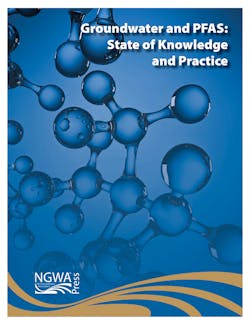The National Ground Water Association has announced the development and release of Groundwater and PFAS: State of Knowledge and Practice.
WESTERVILLE, OHIO, JAN 10, 2018 -- The National Ground Water Association has announced the development and release of Groundwater and PFAS: State of Knowledge and Practice. A 12-month effort by 36 volunteers spending 1100 hours, this comprehensive eight-part guidance document explores these potentially hazardous, and widely discussed, compounds in groundwater and soil.
NGWA published this document to identify the known science and knowledge related to per- and polyfluoroalkyl (PFAS) compounds. It summarizes the fate, transport, remediation, and treatment of PFAS, as well as current technologies, methods, and field procedures used to characterize sites and test remediation and treatment technologies.
According to the U.S. Environmental Protection Agency (USEPA), PFAS are a class of manmade chemicals that are very persistent in the environment and in the human body. Widely used to make products more stain-resistant, waterproof, and/or nonstick, PFAS are sometimes used in the manufacture of products that:
- Keep food from sticking to cookware
- Make upholstered furniture, carpets, and clothing resistant to soil, stains, and water
- Make shoes, clothes, and mattresses more waterproof
- Keep food packaging from sticking to food
- Help fight fires at airfields and other places where petroleum-product-based fires are a risk.
PFAS contamination may be present at some landfills receiving waste since the 1950s and facilities using aqueous film foaming foams (AFFF) such as fire-training facilities, civilian and military airports, petroleum terminals, and refineries. Moreover, any raw materials and commercial products might contain PFAS, and facilities using these products or raw materials might not realize PFAS are present because of unclear packaging or labeling.
While research on the possible health effects of exposure to PFAS is ongoing, NGWA outlines the current information on human exposure in this document. Key findings include:
- Studies have estimated more than 95 percent of the U.S. population has been exposed to PFAS and have measurable concentrations in their blood
- Human exposure to PFAS can occur through ingestion, direct contact, inhalation, and occupational contact
- In humans, the highest PFAS concentrations are detected in serum and liver, and to a lesser extent the kidney and other organs
- PFOA and PFOS are linked to a multiplicity of adverse effects, including hepatic toxicity, reproductive and developmental toxicity, suppression of the immune system, and some types of cancer
- A wide range of regulatory screening levels exist throughout the United States but currently there is no consensus on safe levels for PFAS in soil and water.
In 2016 the USEPA set drinking water health advisories for PFOA and PFOS at 0.07 micrograms per liter, or 70 parts per trillion, equivalent to one grain of salt in 1000 gallons of water. Based on USEPA sampling of water supply systems, up to fifteen million people live in areas where PFAS concentrations are above the USEPA health advisory. Before this document, the groundwater industry did not have consistent and reliable approaches to characterizing and remediating these emerging contaminants.
According to Seth Kellogg, PG, and NGWA Science and Engineers Board member who served as an author of the document, the challenge was amplified by the patchwork of state regulations ranging from non-existent to more stringent than the USEPA health advisory.
"Without a federal regulatory standard, clean-up of PFAS is inconsistent and the various state standards create both legal and public confusion over the risks of the contaminants. It was critical for NGWA to provide the groundwater community with the best available science for evaluating the impacts of PFAS," said Kellogg.
She continued: "NGWA felt this particular group of compounds were so unique, persistent, and pervasive we spent 12 months with 36 volunteers, 14 of whom have Ph.D.’s, to research, then develop, this document. As the Association dedicated to the responsible development of groundwater we felt it was necessary to explore this emerging contaminant so our members and the public have the tools necessary to protect the resource of groundwater and to minimize health threats."
An overview of the document is available for free on NGWA's website.



